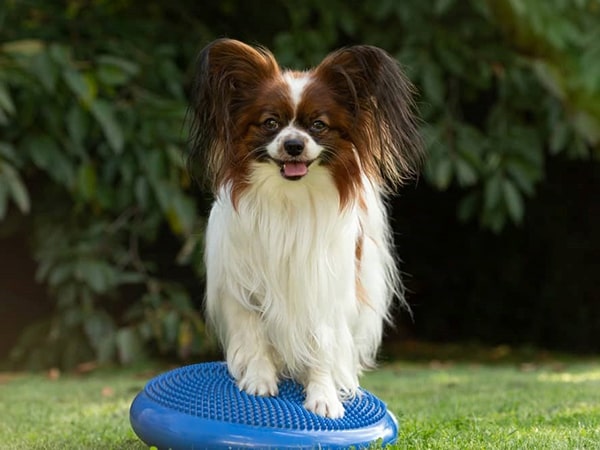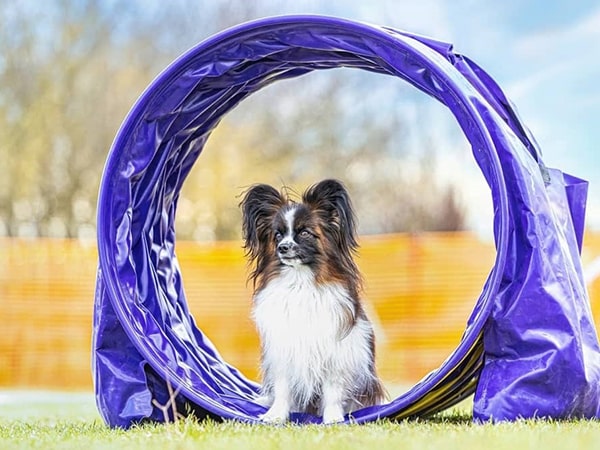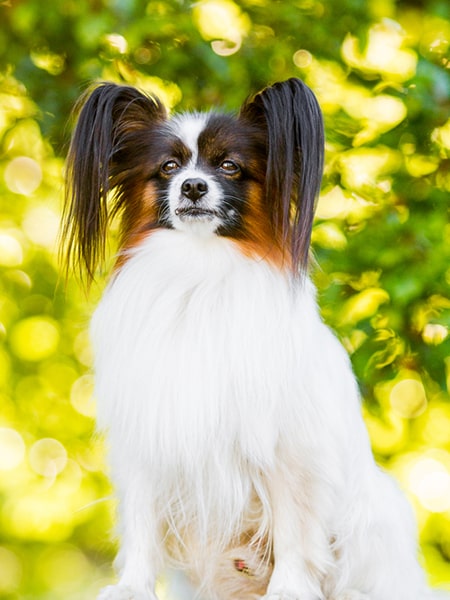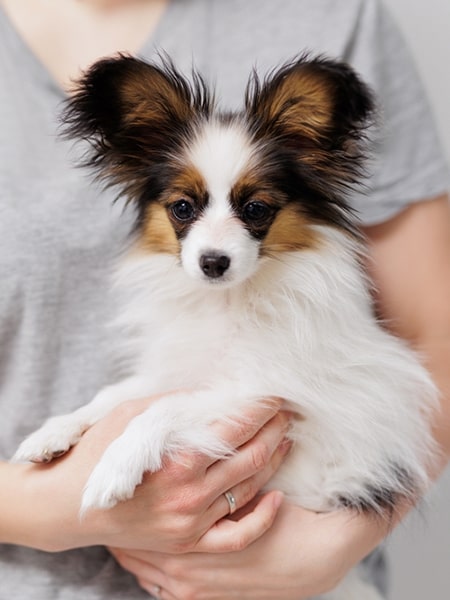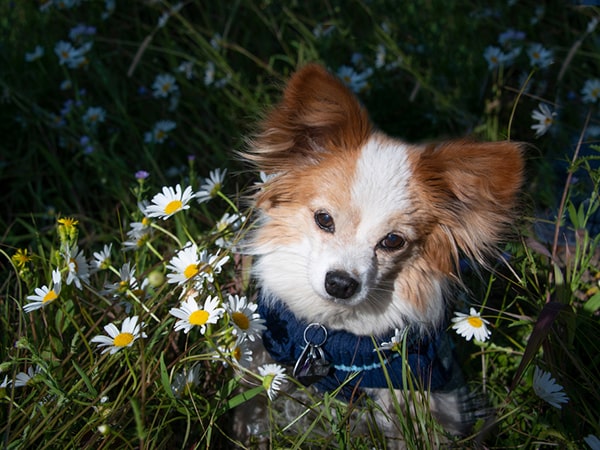This post is also available in:
Français (French)
Español (Spanish)
Papillon dogs are a breed of small, fluffy dogs that have become increasingly popular in recent years.
They’re known for their delicate butterfly-like ears and friendly personalities, making them perfect companion animals.
Papillons make great pets as they require minimal grooming and exercise, but still provide an abundance of love and companionship to their owners.
In this article, we’ll explore the characteristics and history of these adorable pooches so you can decide if one is right for your home.
Table of Contents
History Of Papillons
The Papillon is a small and ancient dog breed that has been beloved by many for centuries. They are believed to have originated in the 1500s when they were bred as lapdogs for French and Spanish royalty. Their name comes from the French word “papillon” meaning butterfly due to their characteristic ears which resemble the wings of a butterfly.
Papillons come in two distinct patterns: phone (droopy-eared) and papillon (butterfly eared). Breeding practices throughout history have favored the latter patterned dogs with erect ears; however, both varieties are recognized under AKC standards today.
The modern Papillon also features a long coat, usually white or cream-colored with patches of other colors including black, brown, red, and sable. This dainty yet sturdy little breed stands up to 8 inches tall at the shoulder and weighs between 4-10 pounds on average.
While they may be small in stature, they certainly make up for it with their big personalities! Papillons are incredibly intelligent and loyal companions who love nothing more than spending time with those closest to them.
Papillon’s Appearance and Temperament
The Papillon breed of dog is a sight to behold, with its show-stopping beauty.
The most recognizable feature of the Papillon is its large, fringed ears and luxuriously long coat that comes in many colors including white and black, sable, red, brown, or mixed color variations. This small-sized pup has a regal bearing that complements its dignified appearance.
Papillons are also known for their lively personalities. These dogs are intelligent and eager to please their owners; they were originally bred as companion animals to French royalty in the 16th century. They love attention from family members but can be shy around strangers. With proper socialization training, however, these dogs will quickly warm up to new people.
On top of that, this breed loves learning tricks and playing games like fetch! Weighing just 4-10 pounds on average when fully grown, Papillons make great companions for apartment dwellers with limited space. Despite their diminutive size, these pups have big hearts and plenty of energy – perfect for those looking for an active pet who won’t take up too much room!
Papillon’s Health and Lifespan
As graceful as a butterfly, the Papillon is an elegant breed of dog. Their luxurious long coat frames their delicate features and perky ears that gracefully rise above the back of their head like wings on an angel in flight. While they are small in size, these dogs possess big personalities, making them fun-loving companions for all ages.
When it comes to health and lifespan, proper feeding guidelines should be followed when caring for a Papillon. Ensuring adequate nutrition helps maintain this hardy breed’s good health throughout its life span of 12 – 15 years.
In addition, regular checkups with a veterinarian and ongoing health screenings can help diagnose potential issues early on. A balanced diet plus moderate exercise keeps those enchanting little legs moving into old age.
Owners need to stay up to date on vaccinations and dewormings to protect against parasites or other illnesses that could affect the quality of life of their furry friends.
With lots of love and attention given to these tiny pooches, you’ll have plenty of time to enjoy every moment spent together!
Grooming Requirements For Papillon
Grooming requirements for dog papillons can seem daunting due to their unique coat textures. However, the task is simpler than it appears. With the right tools and a few simple steps, you’ll be able to keep your pup looking its best in no time!
Bathing tips are essential for keeping your dog’s fur clean and healthy.
A gentle shampoo is recommended as these breeds have sensitive skin. Ensure the water isn’t too hot or cold during bathtime to avoid making them uncomfortable – lukewarm is ideal. Afterward, make sure to thoroughly dry off any excess moisture before allowing them back outside or into other areas of the house.
When it comes to coat trimming, certain techniques should be used depending on how long your pup’s fur is naturally. Longer coats require more frequent grooming than shorter ones but will still need regular trims every four months or so.
For longer hairs, use thinning shears at the ends of each strand while brushing out knots with a wide-toothed comb first if necessary. Shorter hair may only need an occasional scissor cut around the face and legs to prevent tangling.
These care guidelines may take some getting used to, but once you get into a routine, you’ll find it easy enough to maintain your pup’s look over time!
Exercise Needs of Papillons
Papillons are lively, active dogs with moderate exercise intensity. They need regular playtime and walks to stay physically fit and mentally stimulated.
A daily walk of 30 minutes is sufficient for their needs, however, they can handle more if it’s available. If you have the time and energy, long walks or jogging sessions will be appreciated by your pup!
When playing indoors, give your papillon plenty of interactive toys to keep them occupied. Puzzle-style toys that dispense treats when solved are great options as they provide mental stimulation while keeping boredom at bay.
Active games like fetch also work well – just make sure not to overexert your dog’s energy levels so they don’t tire too quickly during playtime duration.
It’s important to remember that all dogs need some form of physical activity to maintain good health; this applies especially to energetic breeds like Papillons! With adequate exercise and enough playtime activities, these smart little pooches will remain happy and healthy throughout their life.
Training And Socialization
Training and socialization are two of the most important aspects when it comes to raising a papillon dog. They need to be given clear boundaries and guidance for them to learn how to behave properly, as well as become comfortable with their environment.
Training can be done through positive reinforcement such as offering treats or verbal praise when they obey commands, while playtime activities provide an outlet for energy and help build stronger relationships between owners and dogs.
Socializing your pup from a young age is also highly recommended. Allowing your pet to interact with people other than yourself, as well as introducing them to new environments will help them develop better behavior habits and prevent any form of aggression towards others.
You should start slowly by exposing them to one person at a time before gradually increasing interactions with larger groups of people, especially if this is their first experience outside of the home.
Constant supervision and care should always be provided during training sessions or when interacting with strangers; this ensures safety while promoting trust between both parties involved. Regular walks around the neighborhood can also prove beneficial since these allow pets to explore beyond familiar areas without feeling overwhelmed or threatened.
With enough patience, consistency, and dedication on your part, you’ll surely have no trouble helping your canine companion reach his full potential!
Papillons Common Behavior Issues
At the end of the day, proper training and socialization are essential to ensure your dog Papillon is well-behaved. With that said, no matter how much effort you put into teaching them good behaviors, they may still display common behavior issues like separation anxiety or destructive chewing.
To make sure these issues don’t get out of control, here are a few tips to master:
How Papillon Interacting With Children
Papillons are great companions for children and can enhance the joys of parenthood. When it comes to socializing with other people, they’re quite friendly as well. To ensure that your little ones have a happy experience with their pup, here are some tips on interacting with them:
By following these steps, you can guarantee that both you and your children will enjoy all the exciting moments shared with this breed! With plenty of love and patience, papillons make great life partners for families looking for a loyal companion who loves being part of the adventure.
| Tips | Description |
|---|---|
| Get interactive toys | Interactive toys help keep papillons entertained and active. Try getting those that encourage physical activity like chewables or tug-of-war ropes. |
| Spend quality time together | Children should be encouraged to spend more quality time playing with their pup by giving belly rubs, brushing its fur, or walking around the house together. It’s important to create an emotional bond between the papillon and the child so that these activities become regular habits rather than occasional events. |
| Socialize responsibly | Papillons need lots of attention from humans but also require proper socialization to get along with new environments and other animals alike. Make sure your pup is comfortable when introducing him/her to new people or places before allowing any interaction. |
Papillons And Other Pets
Have you ever wondered why papillons are some of the most popular pets? Not only do they have fun and friendly personality, but they also have unique characteristics that make them a great companion.
From their feeding habits to their living spaces, there is much to consider when it comes to taking care of these dogs.
Papillons require special attention when it comes to their feeding habits because they can be quite picky eaters. Pet owners need to create a balanced diet with plenty of fresh fruits and vegetables in addition to high-quality dog food. Additionally, treats should be given sparingly as too many could lead to obesity or other health problems.
When it comes to providing appropriate living space, papillons need plenty of exercise opportunities and mental stimulation throughout the day. This means making sure they have access to open areas or even taking them out on walks regularly. Also, having interactive toys available will help keep them active while indoors so that boredom doesn’t set in.
Allowing them enough time outdoors each day helps meet both their physical and emotional needs which ultimately makes for healthier and happier pets overall.
It is clear that proper care is essential for keeping papillons healthy and contented companions; however, by following the steps mentioned above, you can rest assured knowing your pup will receive the best possible care!
Papillon’s Popularity in Different Countries
The papillon dog is a popular breed around the world. It has been bred to meet specific standards in different countries and is seen often at international shows. They are beloved for their happy, outgoing personalities, as well as their long ears and fluffy coats.
Papillons have become increasingly popular over time, especially in Europe and the United States. Here are some of the other places where they can be found:
- Germany: The German Kennel Club recognizes this breed and there are several dedicated clubs in the country.
- Japan: Papillons were first brought to Japan by French traders during the Edo period (1603–1868). Today, these dogs are becoming more common among pet owners thanks to their playful temperaments.
- Canada: This breed is relatively uncommon outside of urban areas but its popularity continues to rise due to its intelligence and loyal nature.
- Mexico: Papillons have only recently been introduced into Mexican culture but they are quickly gaining recognition as excellent family pets.
Due to their friendly personalities, papillons make great companions for people of all ages – from young children to seniors. They require minimal grooming and exercise needs so they fit easily into any home or lifestyle. Whether you’re looking for an affectionate lapdog or an active playmate, the papillon makes a wonderful choice!
Selecting A Papillon Breeder
Choosing the right breeder for your new pup can be a daunting task. It’s important to take the time to do thorough research and verify credentials before making any commitments.
Start by looking up breeders online, joining forums or local pet groups on social media, asking fellow dog owners in your area who they recommend, and visiting kennels and shelters in person if possible.
When you have narrowed down your list of potential breeders, contact them directly with questions about their breeding program, experience, health testing protocols for both parents, vaccinations, and veterinary care given to puppies before delivery. Additionally, inquire about the genetic history of each puppy’s parents and siblings.
Reputable breeders should also provide information regarding diet requirements and general training tips as well as references from previous buyers.
Once you’re confident that all necessary criteria are met, it is essential to view where the puppies were raised. Are they being kept in clean conditions? Is there sufficient space for them to move around freely? Do they seem healthy, happy, and content?
These considerations will ensure you make an informed decision when selecting a Papillon Breeder.
Adopting A Papillon
Picking the perfect pup requires patience and preparation. Papillons are precious pooches that come with plenty of perks, but potential pet parents must be aware of their responsibilities before adopting.
. Papillons are precious pooches that come with plenty of perks, but potential pet parents must be aware of their responsibilities before adopting.
Exploring options such as:
- Examining rescue organizations
- Fostering a commitment to training
- Investigating breeder practices
- Educating themselves on breed-specific needs
are all essential steps when looking for the right dog to bring home. Responsible owners should research thoroughly and understand what it takes to provide proper care and attention to ensure they’re making the best decision for both them and their pups.
It is important to remember that adding any animal into your life is an enduring endeavor full of joys, challenges, and rewards!
Cost Of Owning A Papillon
Owning a Papillon can be an expensive endeavor. Feeding costs for the breed are high, as they require quality food that is rich in protein and fiber to stay healthy.
Furthermore, vet bills should also be taken into consideration when considering getting one of these delightful companions. Vaccinations, regular checkups, and emergency care can add up quickly if not properly managed.
The cost of grooming a Papillon should also not be overlooked – depending on the level of maintenance you desire, monthly visits to the groomer may be necessary. This could include clipping nails, bathing, brushing teeth, trimming fur, or other services needed to keep your pup looking its best.
In addition to all this, potential owners should consider the purchase price itself which will vary based on breeders’ availability and demand in your area.
All in all, it’s important to do research ahead of time so you know what kind of financial commitment you’ll need to make before bringing home your furry friend!
Finding Papillon Rescue Groups
Owning a Papillon requires an investment of both time and money.
To ensure that your pet is healthy and happy, it’s important to find the right dog for you. Fortunately, there are plenty of options available when seeking out this beautiful breed.
As with any adoption process, taking on a rescue Papillon can be rewarding but also comes with challenges. It’s important to research the different organizations as each may have its own set of standards or requirements when considering adopting from them:
- Are they affiliated with the American Kennel Club?
- What type of health screenings do they provide for their dogs?
- Do they adhere to the breed standard?
The good news is that most Papillon rescues will work closely with potential adopters to make sure that everyone involved has realistic expectations about what makes this particular breed so special.
While some might believe these small dogs take less effort than larger breeds, they still need just as much love and attention. From providing daily exercise and mental stimulation to ensuring regular veterinary checkups—it pays off to invest in a pup who needs extra TLC!
Participating In Papillon Clubs
Joining a Papillon club is one of the best ways to become involved in the world of these beloved dogs. Whether you’re a seasoned show dog handler or just looking for advice from more experienced owners, joining a local club can be an invaluable resource.
Joining shows provides exposure and experience that will help both the handler and the pup feel comfortable on the stage. Plus, it’s great fun!
Connecting with other owners through clubs allows new members to find mentors who have been working with their breed for many years. Experienced handlers can provide useful tips about training, grooming, nutrition, and all other aspects of owning a papillon. They also often offer support if there are any issues along the way.
Additionally, most clubs organize social events such as picnics where like-minded people get together to celebrate their furry friends.
Being part of a Papillon club can open up so many possibilities for learning and connecting with others while having lots of fun at the same time. It’s easy to see why so many choose this route when they decide to welcome one of these beautiful creatures into their home!
Conclusion
Papillon is an exceptional breed of dog that can make the perfect companion for those looking for a loyal and affectionate pet.
Plus, not only are these beautiful dogs hypoallergenic – making them great companions for those who suffer from allergies – but they do have personalities that will bring lots of joy into our lives.
However, it’s important to remember that there are many dogs, including Papillons, that need homes and loving families. Adopting a dog from a rescue organization like Bone Voyage Dog Rescue can provide a forever home for a furry friend in need.
Bone Voyage Dog Rescue is a non-profit organization that rescues dogs in Mexico and helps them find adoptive families in the US and Canada. They provide foster care, vet care, and transportation services to ensure that their dogs have bright futures. By adopting a dog from Bone Voyage Dog Rescue, not only are you giving a dog a loving home, but you’re also supporting the efforts to minimize the number of homeless dogs in the area.
So, if you’ve been considering adding a furry friend to your family, why not adopt a Papillon or another dog in need from Bone Voyage Dog Rescue? You’ll be providing a loving home and making a positive impact on the lives of these wonderful dogs!
Frequently Asked Questions
What Food Should I Feed My Papillon?
Are you wondering what food to feed your papillon?
Exercise needs and grooming habits are two important considerations when selecting the best diet for your pup.
Papillons require a balanced, nutrient-rich kibble with adequate amounts of protein and fat that is specifically designed for small breed dogs.
Look for formulas containing high-quality ingredients like fresh meats, fruits, vegetables, and wholesome grains.
Avoid products made with fillers such as corn, wheat, or soy which can trigger allergies in some breeds.
A high-quality kibble should provide all the nutrients needed by your pup while helping maintain healthy teeth and skin.
How Often Should I Take My Papillon To The Vet?
Taking your papillon to the vet for regular check-ups is important for its health and well-being. Depending on the breed, age, and treatment options it may require, a veterinarian can suggest grooming requirements and other preventative care measures that should be taken.
Generally speaking, most vets recommend annual visits or biannual visits at minimum to keep an eye out for any potential issues or diseases. If you have any specific questions regarding how often you should take your pet in for check-ups, it’s best to consult with your veterinarian first.
Are Papillons Hypoallergenic?
‘As the saying goes, ‘small but mighty’ describes the papillon perfectly; not just in terms of size, but also its hypoallergenic qualities.
The breed requires minimal shedding control and exercise requirements for a dog of its stature – making them an ideal pet for anyone with allergies who want to keep their home allergen-free.
Papillons are known to be low shedders which makes it easier to manage dander levels around your house.
Are Papillons Easy To Train?
Papillons are known to be one of the easiest breeds to train, as they are very intelligent and eager to please.
Training can become even easier with socializing techniques that help them understand what is expected from them.
They require regular exercise and mental stimulation to stay happy and healthy.
With consistent training, papillons will learn commands quickly, such as ‘sit’, ‘stay’ or ‘come’.
As long as you’re patient and provide plenty of positive reinforcement during training sessions, these little dogs should pick up new tricks easily!
What Kind Of Environment Is Best For A Papillon?
Papillons are active and inquisitive dogs, so they need plenty of exercise and playtime. This can be both indoors or outdoors, but it’s important to always keep an eye on them since their size makes them easily distracted by other animals or people.
They also require regular grooming – brushing every few days is ideal – as well as occasional baths to maintain healthy fur.
All these needs make a safe backyard with access to a house the best environment for papillons, allowing them the freedom to move around while still being able to get back inside quickly should any dangers arise.


